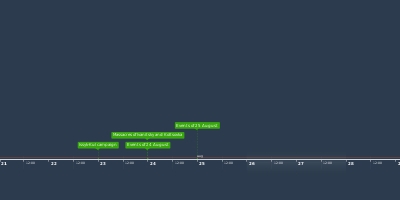19 h 23 m, 9 nov 1917 año - Isdud
Descripción:
By about 08:30 the 1st Light Horse Brigade entered Bureir and around an hour later the 2nd Light Horse Brigade was approaching Friedrich Freiherr Kress von Kressenstein's Eighth Army headquarters at Hulayqat, where an Ottoman rearguard occupied a strong position. The brigade made a dismounted attack capturing 600 prisoners, large amounts of supplies, materiel and an abandoned German field hospital. At midday El Mejdel, 13 miles (21 km) north-east of Gaza, was occupied by the 1st Light Horse Brigade, when they captured 170 prisoners and found a good well with a steam pump, enabling the brigade to quickly water all horses. After passing the ancient town of Ashkelon the Anzac Mounted Division was notified by the Desert Mounted Corps that the XXI Corps was marching up the coast towards El Mejdel and Julis. As the main Ottoman road and railway leading north from Gaza were both cut Chauvel ordered the division to advance towards Bayt Daras, requiring the division to turn north-east. Subsequently the 1st Light Horse Brigade entered Isdud close to the Mediterranean Sea while, on their right, the 2nd Light Horse Brigade captured the villages of Suafir el Sharkiye and Arak Suweidan, a convoy and its escort (some 350 prisoners). As the brigade was reorganising to secure the prisoners, Ottoman guns further north opened fire, shelling both captors and captives alike. Just before dark the 2nd Light Horse Brigade captured a further 200 prisoners, before the Anzac Mounted Division took up a night battle outpost line, along high ground south of the Wadi Mejma, from near Isdud to Arak Suweidan.[163][205]Meanwhile Hodgson's Australian Mounted Division, spent most of 9 November searching for water, which was eventually found at Huj.[204] By the evening of 8 November, the 3rd Light Horse Brigade had not watered since 7 November and the 5th Mounted Brigade since the evening of 6 November, and that if these two brigades were not watered the following day, the divisional war diary reported, "results will be most serious." After relieving these two brigades at 07:30 on 9 November, the 4th Light Horse brigade sent out patrols searching for water. The 12th Light Horse Regiment found one small well at Nejed, while another patrol found two wells at Simsim with basic lifting appliances which made watering very slow. They also found touch with the Anzac Mounted Division. By noon on 9 November the division was watering at Jemmameh, which was not expected to be completed until 18:00.[206] After most of the horses had been watered, they advanced 16 miles (26 km) to the Kastina–Isdud line capturing prisoners, guns, and transports on the way. This march made during the night of 9/10 November was the only night march made during the Sinai and Palestine campaign, through Ottoman territory.[198][207]
The Australian Mounted Division's 12th Light Horse Regiment (4th Light Horse Brigade) advanced north from Burieh to Al-Faluja arriving at 24:00 on 9/10 November when engineering stores and five burnt out aircraft were captured.[208][209] The division was followed by the 4th Light Horse Brigade Field Ambulance and the divisional train made up of brigade transport and supply sections carrying rations. The field ambulance set up a dressing station and treated about 40 wounded men before moving through Huj at 16:00. After encountering rugged mountainous ravines and 6 miles (9.7 km) of very rough terrain, at around midnight they set up camp in a wadi bed.[210]
Barrow's Yeomanry Mounted Division, had been fighting in the Tel el Khuweilfe region until Allenby ordered it to rejoin the Desert Mounted Corps, 20 miles (32 km) away on the coast. Meanwhile, infantry in the 10th (Irish) and 74th (Yeomanry) Divisions remained at Karm, while the 60th (London) Division remained at Huj.
Añadido al timeline:
fecha:
19 h 23 m, 9 nov 1917 año
Ahora mismo
~ 108 years ago
